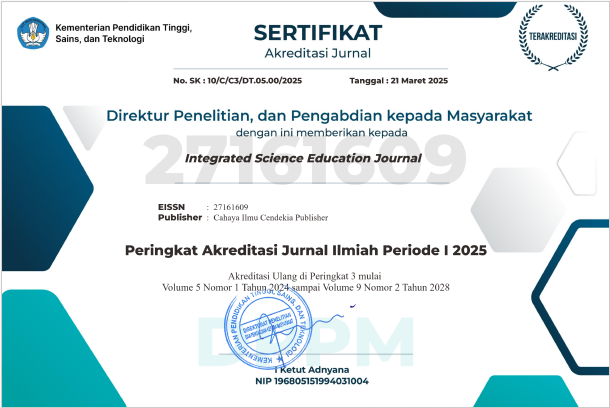Analysis of Student Responses to Student Worksheets Based on Project Based Learning Models
Abstract
Purpose of the study: This research aims to determine student responses to project-based learning in chemistry courses.
Methodology: This research used mixed methods with a sequential explanatory design. The samples involved in this research were 90 students from the chemistry study program. The sampling technique is purposive sampling. The instrument used to collect quantitative data was a questionnaire sheet distributed to students to measure responses, while the instrument to collect qualitative data was interviews conducted with chemistry students. Data analysis was carried out to process quantitative data based on descriptive statistics, and qualitative data was analyzed based on Miles and Huberman's theory and supported by documentation studies.
Main Findings: The results obtained from this research are that chemistry students' responses to project-based learning are classified as good. The importance of the Project Based Learning Model (PjBL) lies in its ability to inspire active involvement in solving real problems, thus facilitating the development of critical and analytical thinking skills.
Novelty/Originality of this study: The latest research is that the research sample involved was from the chemistry education study program to measure the response to project-based learning. This research is limited by only measuring responses, so researchers do not know the truth of the project-based learning process. So, recommendations that can be given in further research are to directly implement the project-based learning process to strengthen the questionnaire results in this research.
References
S. Syaiful, K. Kamid, D. A. Kurniawan, and P. A. Rivani, “The impact of project-based learning on students’ achievement in mathematics,” J. Educ. Res. Eval., vol. 5, no. 4, pp. 558–567, 2021, doi: 10.48081/kxbi5168.
M. D. W. Ernawati et al., “How scaffolding integrated with problem based learning can improve creative thinking in chemistry?,” Eur. J. Educ. Res., vol. 11, no. 3, pp. 1349–1361, 2022, doi: 10.12973/eu-jer.11.3.1349.
A. Astalini, D. Darmaji, D. A. Kurniawan, S. W. Oktavia, E. Triani, and M. Z. Azzahra, “The exploration of character values in physics learning on momentum, impulse, and collision materials,” J. Educ. Res. Eval., vol. 7, no. 2, pp. 277–284, 2023, doi: https://doi.org/10.23887/jere.v7i2.52381.
D. Darmaji, A. Astalini, D. A. Kurniawan, N. Sari, O. H. Wiza, and Y. E. Putri, “Investigation of students’ psychology: The relationship among students’ attitudes, persistence, creativity, and tolerance toward natural science subjects,” Univers. J. Educ. Res., vol. 8, no. 4, pp. 1155–1166, 2020, doi: 10.13189/ujer.2020.080405.
K. Kamid, N. Fajriah, D. A. Kurniawan, and R. I. Widodo, “Elementary school students’ mathematical process skills in gender perspective,” Int. J. Elem. Educ., vol. 6, no. 2, pp. 223–231, 2022, doi: https://doi.org/10.23887/ijee.v6i2.45219.
S. W. Oktavia, N. Septiani, F. Sinaga, and N. N. Qoidah, “Analysis of the relationship in learning interest to learning outcomes static fluid material in senior high school,” J. Ilm. Ilmu Terap. Univ. Jambi, vol. 7, no. 1, pp. 22–26, 2023, doi: https://doi.org/10.22437/jiituj.v7i1.26696.
M. D. W. Ernawati, A. Asrial, R. Perdana, S. E. Septi, S. Rohana, and A. M. Nawahdani, “Evaluation of students’ interest, attitudes, and science process skills in science subjects,” J. Educ. Res. Eval., vol. 6, no. 1, pp. 181–194, 2022, doi: 10.23887/jere.v6i1.37583.
J. Jufrida, W. Kurniawan, A. Astalini, D. Darmaji, D. A. Kurniawan, and W. A. Maya, “Students’ attitude and motivation in mathematical physics,” Int. J. Eval. Res. Educ., vol. 8, no. 3, pp. 401–408, 2019, doi: 10.11591/ijere.v8i3.20253.
A. Astalini, D. Darmaji, D. A. Kurniawan, S. W. Oktavia, and F. P. Sinaga, “Identification of student character values in class x particle dynamics materials,” JIPF (Jurnal Ilmu Pendidikan Fisika), vol. 8, no. 3, pp. 380–388, 2023.
K. P. Mainit and J. A. V. De Leon, “Comparative analysis of teaching strategies used in lessons on culture and lessons on heritage of a selected chinese-filipino school,” J. Educ. Learn., vol. 11, no. 4, pp. 41–51, 2022, doi: 10.5539/jel.v11n4p41.
D. Darmaji, D. A. Kurniawan, and I. Irdianti, “Physics education students’ science process skills,” Int. J. Eval. Res. Educ., vol. 8, no. 2, pp. 293–298, 2019, doi: 10.11591/ijere.v8i2.28646.
K. Kamid, R. Theis, S. Sufri, S. E. Septi, and F. I. Putri, “Comparison of two learning models on students’ process skills in elementary school,” J. Ilm. Sekol. Dasar, vol. 6, no. 3, pp. 446–457, 2022, doi: 10.23887/jisd.v6i3.48681.
H. Sabil, D. A. Kurniawan, R. Perdana, I. F. Putri, and S. E. Septi, “The influence of tarompa e-module on peace-loving characters,” Jurnal Pendidikan Indonesia (JPI), vol. 12, no. 2, pp. 283–292, 2023.
N. Nadirah, A. D. R. Pramana, and N. Zari, “Metodologi Penelitian Kualitatif, Kuantitatif, Mix Method,” 2022.
M. Aizinsh, S. W. Oktavia, R. Firmansyah, and R. Ruttinawati, “Exploration of the character of cooperation in physics,” EduFisika J. Pendidik. Fis., vol. 8, no. 2, 2023.
J. P. Casquilho, F. Sinaga, N. Septiani, S. W. Oktavia, N. N. Qoidah, and E. F. S. Rini, “The influence of critical thinking ability on students’s science learning outcomes,” EduFisika J. Pendidik. Fis., vol. 8, no. 2, 2023.
C. A. P. Vercaruz, N. Septiani, and R. S. Fitriani, “Perbandingan tanggung jawab karakter dan hasil belajar di meksiko dan indonesia di sma pertama,” EduFisika J. Pendidik. Fis., vol. 8, no. 2, 2023.
F. Anggun Parastika and M. Tunjung Hapsari, “Analisis faktor komunikasi, konsep diri, dan lingkungan kerja terhadap kepuasan kerja dengan metode mix method pada karyawan bank syariah indonesia kcp Tulungagung Sudirman,” Reinf. J. Sharia Manag., vol. 1, no. 1, pp. 29–45, 2021, [Online]. Available: http://178.128.61.209/index.php/reinforce/article/view/5454.
A. Astalini, D. Darmaji, W. Kurniawan, K. Anwar, and D. A. Kurniawan, “Effectiveness of using e-module and e-assessment,” Int. J. Interact. Mob. Technol., vol. 13, no. 9, pp. 21–39, 2019, doi: 10.3991/ijim.v13i09.11016.
S. Maharani and M. Bernard, “Analisis Hubungan Resiliensi Matematik Terhadap Kemampuan Pemecahan Masalah Siswa Pada Materi Lingkaran,” JPMI (Jurnal Pembelajaran Mat. Inov., vol. 1, no. 5, p. 819, 2018, doi: 10.22460/jpmi.v1i5.p819-826.
D. Darmaji, A. Astaliini, D. A. Kurniawan, F. I. Putri, and R. Perdana, “Student ’ s need analysis in using ordinary differential equation e- module of Mathematical Physics II,” vol. 7, no. 1, pp. 107–115, 2023, doi: 10.21067/mpej.v7i1.2023.
K. B. Dinata, “Analisis kemampuan literasi digital mahasiswa,” Edukasi J. Pendidik., vol. 19, no. 1, p. 105, 2021, doi: 10.31571/edukasi.v19i1.2499.
L. M. Nasution, “STATISTIK DESKRIPTIF,” J. Hikmah, vol. 14, no. 1, pp. 49–55, 2017, doi: 10.1021/ja01626a006.
V. Amrhein, D. Trafimow, and S. Greenland, “Inferential statistics as descriptive statistics: There is no replication crisis if we don’t expect replication,” Am. Stat., vol. 73, no. sup1, pp. 262–270, 2019, doi: 10.1080/00031305.2018.1543137.
S. Raibowo, Y. E. Nopiyanto, and M. K. Muna, “Pemahaman guru pjok tentang standar kompetensi profesional,” J. Sport Educ., vol. 2, no. 1, p. 10, 2019, doi: 10.31258/jope.2.1.10-15.
M. Mulyati, F. I. Putri, and D. Deswalman, “Efforts to improve student activities and outcomes in physics learning using the two stay two stray technical cooperative learning model at senior high school,” Integr. Sci. Educ. J., vol. 4, no. 1, pp. 30–35, 2023, doi: 10.37251/isej.v4i1.294.
A. Astlini, D. Darmaji, D. A. Kurniawan, N. N. Qoidah, M. Zannah, and E. Triani, “Character values of tenth-grade students during learning physics in vector material,” Jurnal Pendidikan Indonesia (JPI), vol. 12, no. 1, pp. 116–123, 2023.
S. A. Rido, “Pengaruh metode mind mapping dalam peningkatan hasil belajar peserta didik pada mata pelajaran sosiologi kelas XI IPS,” J. Soc. Knowl. Educ., vol. 3, no. 2, pp. 29–33, 2022, doi: 10.37251/jske.v3i2.403.
S. W. Oktavia, H. Mansyur, and M. Hidayat, “Investigasi Keterampilan mengajar guru fisika sman 9 Kerinci,” Relativ. J. Ris. Inov. Pembelajaran Fis., vol. 6, no. 1, pp. 24–30, 2023.
J. P. Casquilho, F. Sinaga, N. Septiani, S. W. Oktavia, N. N. Qoidah, and E. F. S. Rini, “Pengaruh kemampuan berpikir kritis terhadap hasil belajar ipa siswa,” EduFisika J. Pendidik. Fis., vol. 8, no. 2, 2023.
E. Suriyani and D. Desi, “Motivation to learn to read Al-Qur’an students,” JPAII J. Pendidik. Agama Islam Indones., vol. 4, no. 2, pp. 43–48, 2023, doi: 10.37251/jpaii.v4i2.661.
F. T. Aldila, E. F. S. Rini, S. W. Octavia, H. N. Khaidah, F. P. Sinaga, and N. Septiani, “The relationship of teacher teaching skills and learning interests of physics students of senior high school: hubungan keterampilan mengajar guru dan minat belajar siswa fisika sma N 2 Batanghari,” EduFisika J. Pendidik. Fis., vol. 8, no. 1, pp. 101–105, 2023.
A. Astalini, D. Darmaji, D. A. Kurniawan, F. P. Sinaga, M. Z. Azzahra, and E. Triani, “Identification the 2013 curriculum teacher’s book to determine the character values of class x students on circular motion material,” J. Pendidik. Sains Indones., vol. 11, no. 3, pp. 545–558, 2023, doi: https://doi.org/10.24815/jpsi.v11i3.28567.
S. Mundarti and F. T. Aldila, “Affective assessment instrument based on krathwohl-anderson taxonomy in senior high school,” J. Eval. Educ., vol. 4, no. 2, pp. 74–79, 2023, doi: 10.37251/jee.v4i2.323.
J. Jamaludin, S. Kakaly, and J. R. Batlolona, “Critical thinking skills and concepts mastery on the topic of temperature and heat,” J. Educ. Learn., vol. 16, no. 1, pp. 51–57, 2022, doi: 10.11591/edulearn.v16i1.20344.
N. N. Qoidah, S. Surya, and M. Hidayat, “Investigasi Metode Mengajar Guru di SMA N 2 Batanghari pada Pembelajaran Fisika,” KoPeN Konf. Pendidik. Nas., vol. 3, no. 2, pp. 138–142, 2021.
P. R. Amnuel, F. P. Sinaga, and F. R. Winda, “Description of students’ critical thinking ability of urban school in physics material,” Edufisika J. Pendidik. Fis., vol. 8, no. 2, pp. 217–225, 2023, doi: 10.59052/edufisika.v8i2.26531.
R. Hermawati and D. Chen, “Increasing student cooperation through a project-based learning model with the theme of ecosystems,” J. Basic Educ. Res., vol. 4, no. 1, pp. 45–49, 2023, doi: 10.37251/jber.v4i1.299.
M. Dwi Wiwik Ernawati, M. Damris, Asrial, and Muhaimin, “Development of creative thinking skill instruments for chemistry student teachers in Indonesia,” Int. J. online Biomed. Eng., vol. 15, no. 14, pp. 21–30, 2019, doi: 10.3991/ijoe.v15i14.11354.
A. Aziz, A. Fauzan, F. I. Putri, and M.Yudis, “Perbandingan minat belajar ipa fisika siswa pada dua kelas di pondok pesantren,” J. Kependidikan, vol. 15, no. 1, pp. 26–37, 2021.
M. H. Feliza Paramitha Sinaga, Jurhana, Yusrita, “Analisis penggunaan metode mengajar (metode demonstrasi, metode eksperimen, metode inquiry, dan metode discovery) di sma negeri 11 Kota Jambi,” Relativ. J. Ris. Inov. Pembelajaran Fis., vol. 5, no. 2, pp. 103–110, 2022
K. Kamid, S. Syaiful, R. Theis, S. Sufri, and S. Rohana, “Cooperative learning model with process skills for mathematics learning in elementary school,” Int. J. Elem. Educ., vol. 6, no. 1, pp. 58–68, 2021, doi: https://dx.doi.org/10.23887/ijee.v6i1.
Copyright (c) 2023 Yusnidar Yusnidar, Epinur Epinur, Nila A’yun Nadila

This work is licensed under a Creative Commons Attribution-NonCommercial 4.0 International License.
Authors who publish with this journal agree to the following terms:
- Authors retain copyright and acknowledge that the Integrated Science Education Journal is the first publisher licensed under a Creative Commons Attribution 4.0 International License.
- Authors are able to enter into separate, additional contractual arrangements for the non-exclusive distribution of the journal's published version of the work (e.g., post it to an institutional repository or publish it in a book), with an acknowledgment of its initial publication in this journal.
- Authors are permitted and encouraged to post their work online (e.g., in institutional repositories or on their website) prior to and during the submission process, as it can lead to productive exchanges and earlier and greater citation of published work.







.png)
.png)






